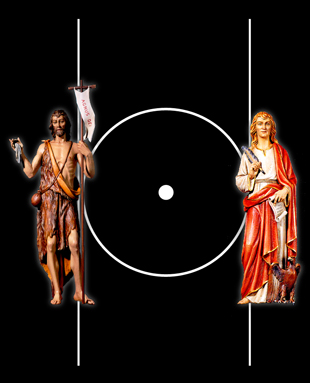A POINT WITHIN A CIRCLE
By Wor. Bro. S. L. Waterman
THE TRACING BOARD
G.L. of Saskatchewan - 1974
Many students regard the symbol of the point within a circle as belonging exclusively to the Third Degree; but if we go back to the old lectures - current in the 1880's and even more recently - we find that this symbol enters into the explanation of the First Tracing Board, and further, is referred to in the 6th section of the 1st lecture. It figures on many of the old First Degree Tracing Boards, and the lectures tell us that "in all regular, well-informed constituted lodges, there is a point within a circle from which a Mason cannot err; this circle is bounded North and South by two grand parallel lines, the one representing Moses, the other King Solomon; on the upper part of the circle rests the V.S.L. which supports Jacob's ladder - the top of which reached to heaven."
The point within a circle is a remarkable emblem; but let us look first at the circle itself. The circle having neither beginning nor end, is a symbol of the Deity and of eternityand it follows that the compasses have been valued as being a means by which that perfect figure may be drawn. Everywhere in every age, the circle has been credited with magical properties and in particular has been thought to protect from external evil everything enclosed within it. Folklore contains countless instances of people, houses, places, threshed corn, etc., being protected by the simple means of describing a circle around them. The innocent child could be placed within a circle, in which it was thought to be safe from any outside malevolent influence. The virtues of the circle were also attributed to the ring, the bracelet, the ankle and the necklace which have been worn from earlier times, not only as ornaments but as a means of protecting the wearer from evil influences.
The completed emblem - the point within the circle - has been borrowed, consciously or otherwise from some of the earliest of the pagan rites, in which it represented the male and female principles and came in time to be the symbol of the sun and the universe. Phallic worship was common throughout the ancient world, simple people being naturally inclined to adopt as the foundation of their religion so great a mystery as the generative principle. The symbol came to be regarded as the sign of the Divine creative energy. Freemasonry adopted the symbol and easily gave it a geometrical explanation:
Q. What is a centre?
A. That point within a circle from which every part of the
circumference is equally distant
Q. Why in the centre?
A. Because that is a point from which a M.M. cannot err.
The ancient peoples in giving great religious prominence to phallic emblems apprehend no wrong in so doing. L.M. Child has said: "Reverence for the mystery of organized life led to the recognition of a masculine and feminine principle in all things spiritual or material . . . . the active wind was masculine, the passive or inert atmosphere was feminine . . . the sexual emblems conspicuous in the sculptures of ancient temples would seem impure in description, but no clean and thoughtful mind could so regard them . . . . . the ancient worshipped the Supreme Being as the Father of men and saw no impurity in denoting with phallic emblems the kinship of mankind to the Creator."
Some students hold that the point within the circle represented to the ancients the whole scheme of the universe, one point being the individual, or contemplator, and the circle the horizon.
What is This World Coming To, and When Will It All End?
"What is this world coming to, and when will it all end? . . . How often we hear that nowadays, frequently followed by, "Well, we can't do much about it," in atone of resignation. Certainly there is sufficient restlessness, and trouble about to cause a feeling of despair. But history does record many examples of men and women, who buoyed up by a clear and definite goal in life, have overcome difficulties and changed conditions of the time and place.
Here we are then, Freemasons, here is your challenge.

